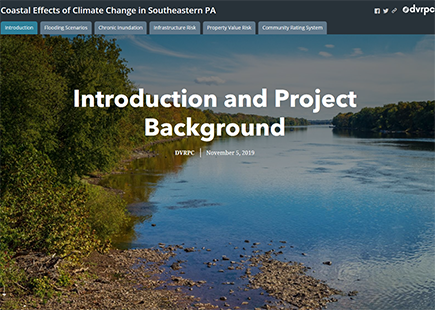Increases in temperature associated with climate change are predicted to cause higher sea levels and more frequent heavy storms, both of which will introduce new degrees of flooding vulnerability that communities will need to address. This page serves as a resource for municipalities, especially those along or near the Delaware River in Pennsylvania, who are are looking for information to help them plan for increased flooding.
PA Coastal Resiliency Story Map
This story map shows current and future flood scenarios in Pennsylvania's Delaware Estuary Coastal Zone, as well as potential impacts to property value and critical municipal facilities. Information on the benefits that municipalities and property owners may receive by participating in the Community Rating System, a voluntary national program incentivizing flood prevention while reducing flood insurance premiums for property owners, is also included.

Flooding Problems for Municipalities in the Delaware Estuary Coastal Zone (DECZ)
In the fall of 2017, DVRPC sent a survey to staff from DECZ municipalities to learn about historic flooding issues in these municipalities, steps they have taken to address these issues, and their concerns regarding future floods. Thirteen municipalities responded out of a total 29 that were contacted (44.8 percent). The main concerns of respondents fit into the following categories:
- Flooding of private property (homes, cars, commercial buildings), especially residential basements
- Flooding of roadways
- Stress on aging flood mitigation and stormwater infrastructure (sewer lines, storm drains, inlets, dikes, levees)
- Secondary effects of flooding: siltation, erosion, pollution
- Destruction of tidal wetland habitat
- Insufficient flood monitoring systems
What Can Municipalities Do About Flooding?
- Plans, Regulations, and Ordinances [0.27 MB pdf]
- Municipal Operations Activities [0.32 MB pdf]
- Projects [0.32 MB pdf]
- Outreach [0.21 MB pdf]
The majority of the recommendations and resources are derived from two sources:
- Getting to Resilience reports written in 2015 by the Jacques Cousteau National Estuarine Research Reserve (JCNERR).
- Chester City’s Climate Adaptation Planning Element in its Vision 2020 Master Plan, which DVRPC co-authored in 2014 with the project leaders, Pennsylvania Sea Grant, and the rest of the Chester Hazards and Climate Adaptation Project Team.
How Can This Work Be Funded?
Although finding funding for community resiliency projects can be challenging, many government and private sector organizations are increasingly focusing their resources on helping communities to better prepare for and adapt to a changing climate and future floods.
The resource list below is not exhaustive, but rather represents a selection of funding and programs available at the time of publication (December 2017). The Pennsylvania Silver Jackets Interagency Flood Mitigation Program Guide, which was updated in October 2015, also provides information on federal, state, and local programs available to assist municipalities with flood mitigation activities.
- FEMA Grants [0.18 MB pdf]
- Other Federal Grants [0.22 MB pdf]
- Pennsylvannia Grants [0.17 MB pdf]
- Regional, County, and Local Funding [0.15 MB pdf]
- Private Sector Grants [0.10 MB pdf]
More information on a wide variety of financial assitance can be found through DVRPC's Municipal Resource Guide.